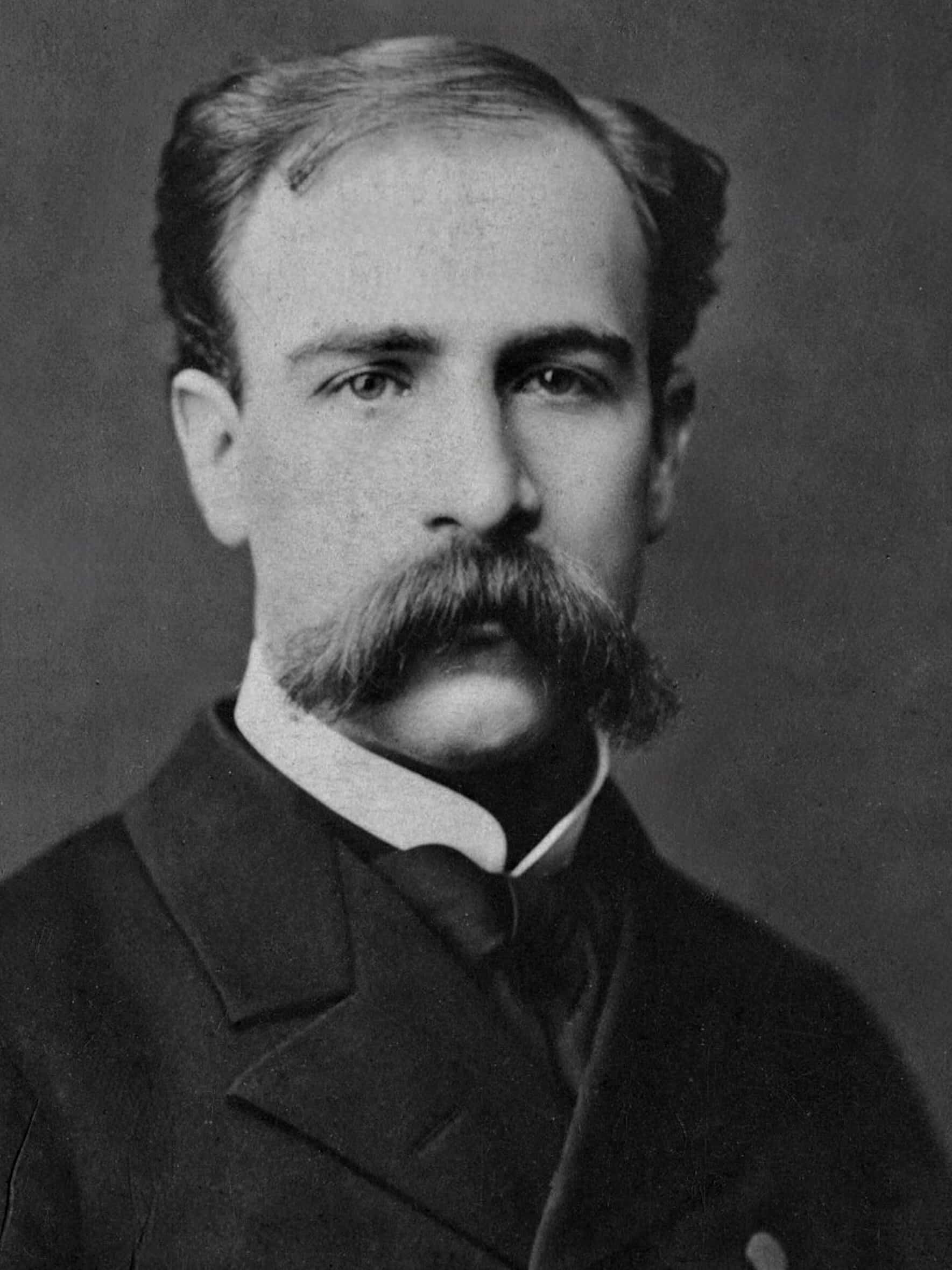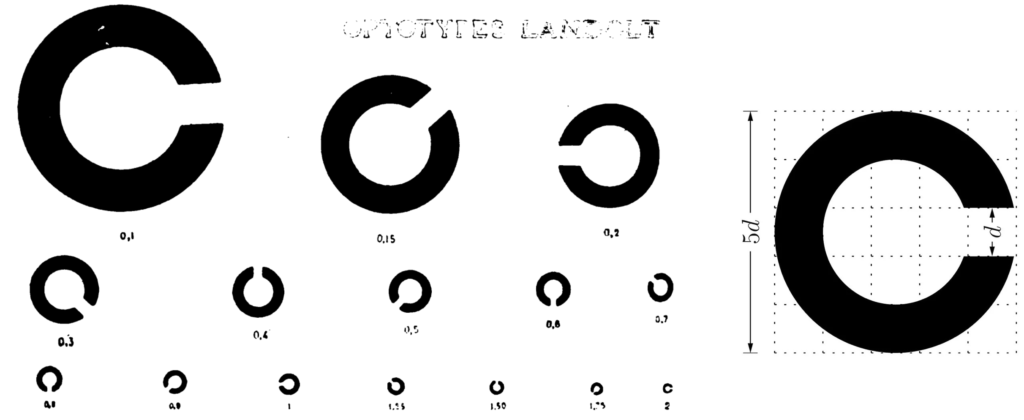Edmond Landolt

Jacques Rodolphe Edmond Landolt (1846-1926) was a Swiss-born ophthalmologist
Landolt’s innovations transformed the measurement of visual acuity and advanced understanding of ocular motility. Educated in Zurich and influenced by leading figures such as Snellen, Donders, and von Graefe, he combined rigorous physiology with clinical acumen. After early service in the Franco-Prussian War, he settled in Paris in 1874, where he became a central figure in European ophthalmology.
Landolt introduced the Landolt C (Landolt ring) in 1899—an optotype consisting of a broken ring with a gap at varying orientations—providing a universal, literacy-independent standard for measuring visual acuity. Today, it remains the international reference for acuity testing (ISO 8596). He also discovered Landolt’s bodies in the retina and advanced surgical treatment of ocular motility disorders, notably strabismus.
A prolific author, Landolt co-founded Archives d’Ophtalmologie, co-directed the Laboratoire d’Ophtalmologie with Javal, and wrote authoritative works on refraction and muscle imbalance. Honoured with the Légion d’Honneur and multiple international distinctions, he influenced ophthalmology through his research, clinical innovations, and insistence on universal standards in eye care.
Biographical Timeline
- 1846 – Born May 17 in Aarau, Switzerland (legal name later recorded as Jacques Rodolphe Edmond Landolt; likely Jakob Rudolf Edmund Landolt at birth).
- 1869 – Doctorate in Medicine, University of Zurich; trained with Arlt, Helmholtz, Snellen, and Donders.
- 1871 – Served with Swiss ambulance during Franco-Prussian War; contracted enteric fever at Belfort.
- 1874 – Settled in Paris; appointed oculist to the Institut National des Jeunes Aveugles; worked with Charcot at Salpêtrière.
- 1880 – Co-founded Archives d’Ophtalmologie; co-directed Laboratoire d’Ophtalmologie with Émile Javal.
- 1899 – Introduced the Landolt C optotype, described in Nouveaux objets-types pour la détermination de l’acuité visuelle.
- 1911 – Delivered Bowman Lecture on ophthalmic surgery; honored internationally.
- 1926 – Died May 9 in 8e Arrondissement, Paris, France aged 79; buried at Montparnasse Cemetery (tombstone reads Edmond Landolt)
Medical Eponyms
Landolt C
Landolt introduced the Landolt C (or Landolt ring) as a universal optotype in his 1899 paper Nouveaux objets-types pour la détermination de l’acuité visuelle (Archives d’Ophtalmologie, 1899). Designed to eliminate literacy bias and provide a reproducible standard, the Landolt C consists of a broken ring with a gap at one of eight orientations. Design principles include:
- Outer diameter subtends 5 minutes of arc at the testing distance.
- Stroke width and gap width equal 1/5 of the ring diameter.
- The patient identifies the direction of the gap, ensuring that the test measures visual resolution alone.
The Landolt C remains the international reference optotype, adopted in DIN 58220 and ISO 8596 standards. While Snellen optotypes dominate clinical use, the Landolt ring is preferred in research and regulatory testing for its precision and neutrality across languages.
Ces objets-types sont basés sur ce principe adopté partout: déterminer le plus petit angle sous lequel l’œil distingue deux points comme étant séparés. L’écartement des deux points est représenté par une solution de continuité dans des cercles noirs sur fond blanc.
Nos tableaux contiennent seize cercles de différentes dimensions. Ils sont destinés à être placés de préférence à une distance de 5 mètres tres de l’œil examiné. Les chiffres marqués sous les cercles indiquent alors le degré de l’acuité visuelle de l’œil qui en distingue juste encore la solution de continuité.
On comprend sans peine les avantages que ces objets-types…Lettres et chiffres ne peuvent servir d’abord que pour les lettrés. Nos cercles sont les mêmes pour tout le monde. ils représentent pour tout le monde le même problème simple Ils constituent, de plus, des objets-types vraiment internationaux
Standard symbols have been used to determine the smallest angle at which the eye distinguishes two points as separate. Here, the distance between the two points is represented by a break in continuity in black circles on a white background.
Our tables contain sixteen circles of varying sizes…placed preferably 5 meters from the eye under examination. The numbers under the circles indicate the degree of visual acuity of the eye that still just distinguishes the break in continuity.
Letters and numbers can only be used primarily by literate people. Our circles are the same for everyone and present the same simple to all. Moreover, the symbol is recognised internationally.

Landolt Bodies (1871)
Small, elongated, clavate bodies lying between the rods and cones and resting upon the outer nuclear layer of the retina
In his early histological work on the retina, Landolt described elongated club-shaped processes between the inner segments of cones and Müller cells, structures later termed Landolt’s bodies. These findings, discussed in late 19th-century ophthalmic histology and summarized by Polyak (The Retina The anatomy and the histology of the retina in man, ape, and monkey, 1941), contributed to understanding the structural organization of the photoreceptor layer.
Key Medical Contributions
Ocular Motility and Strabismus Surgery
Landolt was a leading authority on extraocular muscle physiology and surgical correction of strabismus. He refined surgical approaches to muscle insufficiency and convergence anomalies, emphasizing graduated tenotomies and advancements to balance ocular alignment without overcorrection.
His textbook The refraction and accommodation of the eye and their anomalies (1886) became a cornerstone for understanding binocular vision disorders. Landolt also pioneered diagnostic techniques to quantify ocular muscle action and convergence range.
Landolt and Sherlock Holmes
Arthur Conan Doyle, creator of Sherlock Holmes, studied ophthalmology in Vienna (1890) and spent time in Paris, where he reportedly met Edmond Landolt, then a leading European eye surgeon. Doyle opened a short-lived ophthalmic practice in London in 1891 before turning to full-time writing. His medical training and Parisian connections often surfaced in his fiction, including references to ocular disorders.
Landolt even appears as a character in the Sherlock Holmes pastiche The Demon Device (Robert Saffron, 1981), underscoring his enduring reputation beyond medicine.
Professional Life and Honours
- Appointed oculist to the Institut National des Jeunes Aveugles in Paris and consultant at Salpêtrière, collaborating with Charcot on neurological-ophthalmic cases.
- Declined professorships at Berne and Zurich, choosing independence in Paris.
- Recognized internationally: Chevalier of the Légion d’Honneur; recipient of foreign orders from Austria, Belgium, and Spain
Legacy in Visual Science
Landolt’s contributions spanned clinical ophthalmology, visual psychophysics, and anatomical research. His Landolt C remains the benchmark for international standards in acuity testing, while his investigations into ocular motility and retinal structure influenced surgical and diagnostic paradigms well into the 20th century.
La précision en ophtalmologie repose sur des méthodes universelles
Controversies
Edmund or Edmond?
Landolt’s full legal name evolved with geography and language. Born in Aarau, Switzerland, he was likely registered as Jakob Rudolf Edmund Landolt in Switzerland. His official French death certificate (1926) records him as Jacques Rodolphe Edmond Landolt, and his tombstone in Paris bears the name Edmond Landolt. [Tombstone][Death Certificate]
French medical literature consistently used Edmond, reflecting his Parisian career, whereas German references favour Edmund, the spelling adopted in modern ophthalmology and ISO standards. Both forms are historically accurate; the variation mirrors his bilingual, transnational identity.
Major Publications
- Landolt E. Die Einführung des Metersystems in Ophthalmologie 1876 [The introduction of the metrical system into ophthalmology]
- Landolt E. Leçons sur le diagnostic des maladies des yeux. 1877 [A manual of examination of the eyes]
- Landolt E. Manuel d’ophthalmoscopie. 1878
- Landolt E. On myopia. 1879
- Landolt E. The artificial eye 1879
- de Wecker L, Landolt E. Traité complet d’ophthalmologie. 1880 [Vol II 1886][Vol III 1887]
- Snellen H, Landolt E. Ophthalmométrologie. 1880
- Landolt E. Étude sur les mouvements des yeux à l’état normal et à l’état pathologique. 1881
- Landolt E. The refraction and accommodation of the eye and their anomalies. 1886
- Landolt E. Clinique ophthalmologique du Dr E. Landolt : leçon d’ouverture du cours de chirurgie oculaire. 1890
- Landolt E. Cataract-operation, in our time. 1892
- Landolt E. Nouveaux objets-types pour la détermination de l’acuité visuelle. 1899 [Landolt C]
- Landolt E. Nouveaux opto-types pour la détermination de l’acuité visuelle. Archives d’Ophtalmologie 1899; 19: 465-471 [PDF] [Landolt C]
- Landolt E. L’intervention chirurgicale dans la paralysie des muscles oculaires. 1903
- Landolt E. Die Vereinheitlichung der Bestimmung der Sehschärfe. 1905
- Landolt E. Defective ocular movements and their diagnosis. 1913
References
Biography
- Dr. Edmond Landolt. Br J Ophthalmol. 1926 Aug;10(8):463
- Landolt, Edmond. BNF
- Edmund Landolt. Historische Lexikon der Schweiz
- Tombstone: Edmond Landolt. Cimetière du Montparnasse – Division 10 Paris (Paris, France)
- Death certificate as Jacques Rodolphe Edmond Landolt [Image]
Eponym
the person behind the name
BA MA (Oxon) MBChB (Edin) FACEM FFSEM. Emergency physician, Sir Charles Gairdner Hospital. Passion for rugby; medical history; medical education; and asynchronous learning #FOAMed evangelist. Co-founder and CTO of Life in the Fast lane | On Call: Principles and Protocol 4e| Eponyms | Books |
